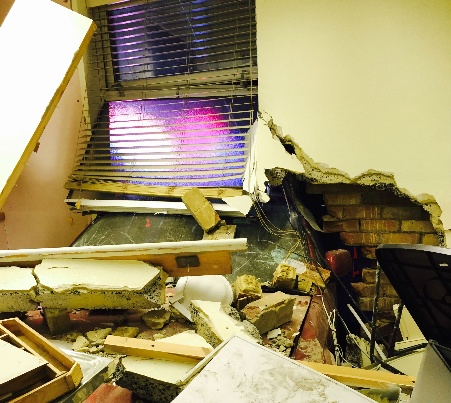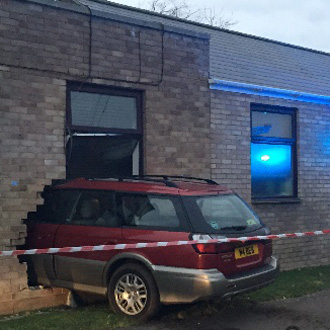It was a normal Monday afternoon. Actually it wasn’t normal, I was feeling quite positive. I’d had a lunchtime meeting so productive that I had to resist the urge to high five my colleagues on the way out. What’s more, mid-way through afternoon surgery I was running to time.
But this is general practice. The calm was interrupted by what sounded like a rubbish violin, followed what I can only describe as a kaboom. It sounded distant so I wasn’t worried. Then the fire alarm went off.
As I walked outside I saw two knocked-over concrete bollards. It was the least exciting accident ever.
‘Hurrah! Everything is fine!’, I thought, before turning to see a car boot sticking out of the building.
The driver managed to climb out of the back seat, looking a bit confused as to what to do next. Someone nipped back into the building to turn the gas off – a good idea, since the car seemed mostly in the kitchen, possibly partly in the boiler room. The duty doctor checked the driver over and she was taken off in an ambulance.
Thankfully, the kitchen had been briefly empty at the time of the crash and everyone was accounted for. The duty doctor headed off with a receptionist to the branch surgery to see if she could set up there and we contacted the CCG and 111.
The experience was a huge learning curve. Here’s what the incident taught me:
1 Rehearse your contingency plan
The phone/internet lines had been severed and we were not allowed inside the building (which significantly hampers a successful afternoon surgery). By 6.30pm the car was removed, but the building was boarded up.
Luckily we had a contingency plan. A room at a nearby practice to be used as an emergency clinic. Of course this didn’t work – the computer said no. But with amazing support from the CCG IT lead (who arrived with an engineer at 8am) we got the branch surgery computers working sans server. We diverted calls to the puny analogue branch surgery phoneline, installed a prescription computer in the kitchen and ran three clinics at a time in series, taking them in shifts, with a few doctors staying at the main surgery seeing walk-ins.

2 Set up a protocal for being forced offline
We rely heavily on computers and phones. Word spreads quickly, but this doesn’t account for isolated housebound people trying to phone for visits and not getting through. Thankfully we had no fallout and by 7pm, just over 24 hours after the crash, we were back online. Think about how your surgery would cope in a situation like this, setting up a clear protocol to follow and testing it out.
3 Getting back to basics is no bad thing
Sometimes you need a bit of a reset to remind you why you do your job. For a while the focus was shifted from all the things we get so tangled up in (politics, NHS changes, demand, resources), and back onto good solid patient care. Every single member of the team cracked on and did what needed to be done in the face of huge stress and disruption. We were fortunate that the damage was only to the building and there were no serious injuries. And I realised the true power of Tupperware when my salad box was rescued from the rubble unscathed.
4 Life is cold without heating
We bought emergency heaters which did not do much to warm us up, but the gas was turned back on after 48 hours. By then it was business as usual. The upstairs sink had become the kitchen/tea-station. We now await refurbishment at the hands of the car insurance company and the builders, thankfully at little cost to us.
5 Community matters
Our patients were understanding, concerned and kind, and we were inundated with good wishes and offers to help. Even local locums offered to lend a hand where needed. This demonstrated the importance of treating patients, staff and community with respect and good care – you never know when you might need some back.
Dr Michael Banna is a GP in Bognor Regis.
















